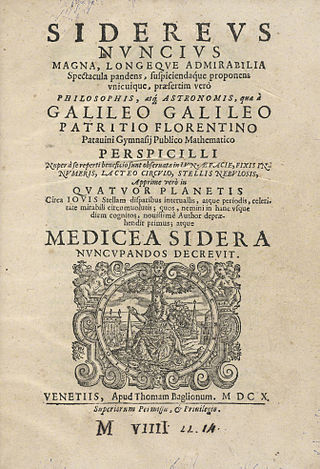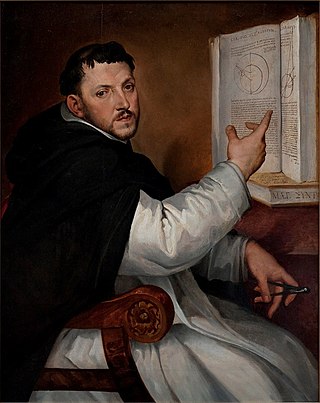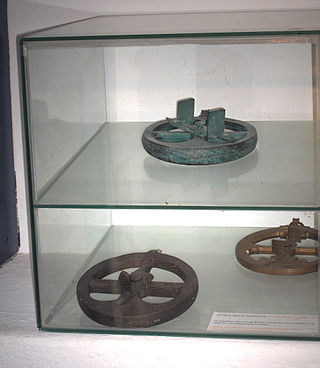
Rudolf II was Holy Roman Emperor (1576–1612), King of Hungary and Croatia, King of Bohemia (1575–1608/1611) and Archduke of Austria (1576–1608). He was a member of the House of Habsburg.

An astrolabe is an astronomical instrument dating to ancient times. It serves as a star chart and physical model of visible heavenly bodies. Its various functions also make it an elaborate inclinometer and an analog calculation device capable of working out several kinds of problems in astronomy. In its simplest form it is a metal disc with a pattern of wires, cutouts, and perforations that allows a user to calculate astronomical positions precisely. It is able to measure the altitude above the horizon of a celestial body, day or night; it can be used to identify stars or planets, to determine local latitude given local time, to survey, or to triangulate. It was used in classical antiquity, the Islamic Golden Age, the European Middle Ages and the Age of Discovery for all these purposes.

Antonio Allegri da Correggio, usually known as just Correggio was an Italian Renaissance painter who was the foremost painter of the Parma school of the High Italian Renaissance, who was responsible for some of the most vigorous and sensuous works of the sixteenth century. In his use of dynamic composition, illusionistic perspective and dramatic foreshortening, Correggio prefigured the Baroque art of the seventeenth century and the Rococo art of the eighteenth century. He is considered a master of chiaroscuro.

Sidereus Nuncius is a short astronomical treatise published in Neo-Latin by Galileo Galilei on March 13, 1610. It was the first published scientific work based on observations made through a telescope, and it contains the results of Galileo's early observations of the imperfect and mountainous Moon, of hundreds of stars not visible to the naked eye in the Milky Way and in certain constellations, and of the Medicean Stars that appeared to be circling Jupiter.

Christoph Scheiner SJ was a Jesuit priest, physicist and astronomer in Ingolstadt.

John Greaves was an English mathematician, astronomer and antiquarian.

Galileo Ferraris was an Italian university professor, physicist and electrical engineer, one of the pioneers of AC power system and inventor of the induction motor although he never patented his work. Many newspapers touted that his work on the induction motor and power transmission systems were some of the greatest inventions of all ages. He published an extensive and complete monograph on the experimental results obtained with open-circuit transformers of the type designed by the power engineers Lucien Gaulard and John Dixon Gibbs.

Medieval Islamic astronomy comprises the astronomical developments made in the Islamic world, particularly during the Islamic Golden Age, and mostly written in the Arabic language. These developments mostly took place in the Middle East, Central Asia, Al-Andalus, and North Africa, and later in the Far East and India. It closely parallels the genesis of other Islamic sciences in its assimilation of foreign material and the amalgamation of the disparate elements of that material to create a science with Islamic characteristics. These included Greek, Sassanid, and Indian works in particular, which were translated and built upon.

IgnazioDanti, O.P., born Pellegrino Rainaldi Danti, was an Italian Roman Catholic prelate, mathematician, astronomer, and cosmographer, who served as Bishop of Alatri (1583–1586).

Museo Galileo is located in Florence, Italy, in Piazza dei Giudici, along the River Arno and close to the Uffizi Gallery. The museum, dedicated to astronomer and scientist Galileo Galilei, is housed in Palazzo Castellani, an 11th-century building which was then known as the Castello d'Altafronte.

The Assayer is a book by Galileo Galilei, published in Rome in October 1623. It is generally considered to be one of the pioneering works of the scientific method, first broaching the idea that the book of nature is to be read with mathematical tools rather than those of scholastic philosophy, as generally held at the time.

Silvio A. Bedini was an American historian, specialising in early scientific instruments. He was Historian Emeritus of the Smithsonian Institution, where he served on the professional staff for twenty-five years, retiring in 1987.

Georg Hartmann was a German engineer, instrument maker, author, printer, humanist, priest, and astronomer.

The mariner's astrolabe, also called sea astrolabe, was an inclinometer used to determine the latitude of a ship at sea by measuring the sun's noon altitude (declination) or the meridian altitude of a star of known declination. Not an astrolabe proper, the mariner's astrolabe was rather a graduated circle with an alidade used to measure vertical angles. They were designed to allow for their use on boats in rough water and/or in heavy winds, which astrolabes are ill-equipped to handle. It was invented by the Portuguese people, a nation known for its maritime prowess that dominated the sea for multiple centuries. In the sixteenth century, the instrument was also called a ring.

A quadrant is an instrument used to measure angles up to 90°. Different versions of this instrument could be used to calculate various readings, such as longitude, latitude, and time of day. Its earliest recorded usage was in ancient India in Rigvedic times by Rishi Atri to observe a solar eclipse. It was then proposed by Ptolemy as a better kind of astrolabe. Several different variations of the instrument were later produced by medieval Muslim astronomers. Mural quadrants were important astronomical instruments in 18th-century European observatories, establishing a use for positional astronomy.
Giovanni Faber was a German papal doctor, botanist and art collector, originally from Bamberg in Bavaria, who lived in Rome from 1598. He was curator of the Vatican botanical garden, a member and the secretary of the Accademia dei Lincei. He acted throughout his career as a political broker between Maximilian I, Elector of Bavaria and Rome. He was a friend of fellow Linceian Galileo Galilei and the German painters in Rome, Johann Rottenhammer and Adam Elsheimer. He has also been credited with inventing the name "microscope".
Philip II of Spain has inspired artistic and cultural works for over four centuries, as the most powerful ruler in the Europe of his day, and subsequently a central figure in the "Black Legend" of Spanish power. The following list covers representations of him in drama, opera, film, novels, and verse. A small selection of the many artistic portrayals of Philip is shown in gallery form.

Galileo di Vincenzo Bonaiuti de' Galilei, commonly referred to as Galileo Galilei or simply Galileo, was an Italian astronomer, physicist and engineer, sometimes described as a polymath. He was born in the city of Pisa, then part of the Duchy of Florence. Galileo has been called the father of observational astronomy, modern-era classical physics, the scientific method, and modern science.
Odo van Maelcote, (b. Brussels 28 July 1572, d. Rome 14 May 1615) was a Jesuit priest, scientist and mathematician from the Spanish Netherlands.

Erasmus Habermehl, also Erasmus Habermel was a major watchmaker and maker of astronomics and geodesy instruments of the 16th century, who last worked as a court instrument maker at the court of Emperor Rudolf II. in Prague.

















